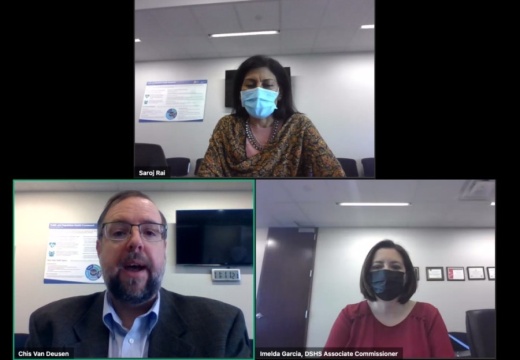“That is a remarkable accomplishment, and it means that nearly one out of every 13 Texans at least 16 years of age have had a vaccine,” said Imelda Garcia, associate commissioner for laboratory and infectious disease services. “But, more importantly, for Texans 65 and older, that’s more than one out of every six ... who have received a COVID-19 vaccine.”
Still, many questions remain regarding the state’s vaccine distribution plan.
Due to a rash of media queries and a relentless onslaught of new COVID-19 cases, the Texas Department of State Health Services held a webinar press conference Jan. 28 featuring updates on the state’s vaccine distribution plan.
The presser came on the heels of a Jan. 24 state profile report showing that while the total number of cases reported was down 12% from the previous week, Texas netted 138,386 new COVID-19 cases—a rate of 477 per 100,000 residents. Texas’ death rate also increased 5% from the previous week, with a total of 2,257 deaths, per the report.
That took six weeks, and Garcia acknowledged there is still a long way to go.
Garcia said federal vaccine shipments will go up from 313,000 this week to about 385,000 next week, and staffers have been informed that increased rate should hold for at least the next few weeks.
There will also be a one-time boost of roughly 126,000 first doses coming from the federal government next week, and DSHS staffers will use that dump to try to send more vaccines to as-yet-underserved areas.
With regard to the coming shift from vaccinating the Phase 1B population—those who are more likely to become very sick or die if they are infected with COVID-19—to the next group, tentatively called Phase 1C, answers are not yet available, Garcia said.
Based on new information that should be forthcoming from the President Joe Biden administration, as well as continued monitoring of weekly data centered on progress of the distribution process, Garcia said DSHS staffers are still discussing the next group to be vaccinated and who will be in it.
“We will announce that once we have come to a final decision ... and communicate that broadly,” she said. “As far as when we transition to the 1C population, ... that really is dependent on the vaccine supply and how quickly we get through our 1B population. That has yet to be determined.”
Just as there was an overlap with the switch from Phase 1A to Phase 1B, there will be some overlap from 1B to 1C, she said.
There should also be more information forthcoming on vaccination data across racial lines, Garcia said, as DSHS staff is working on requiring that information from those reporting their weekly totals back to the state department.
DSHS staff cannot yet say for certain when there will be a shift from the current system to designated hubs to more specific health care providers. As vaccine shipments increase, so should the dispersal to smaller providers, Garcia said, adding that the focus continues to be on areas that can facilitate high rates of vaccination week to week.
The biggest allocations of vaccines so far has been in the state’s urban and suburban areas, and that is largely because of initial efforts to get the vaccine to health care workers in dense population centers, Garcia said.
“We have made a really strong start here in Texas, getting folks vaccinated and taking critical steps toward ending the pandemic, but we still have a long way to go,” Garcia said. “We’ll get there together.”





